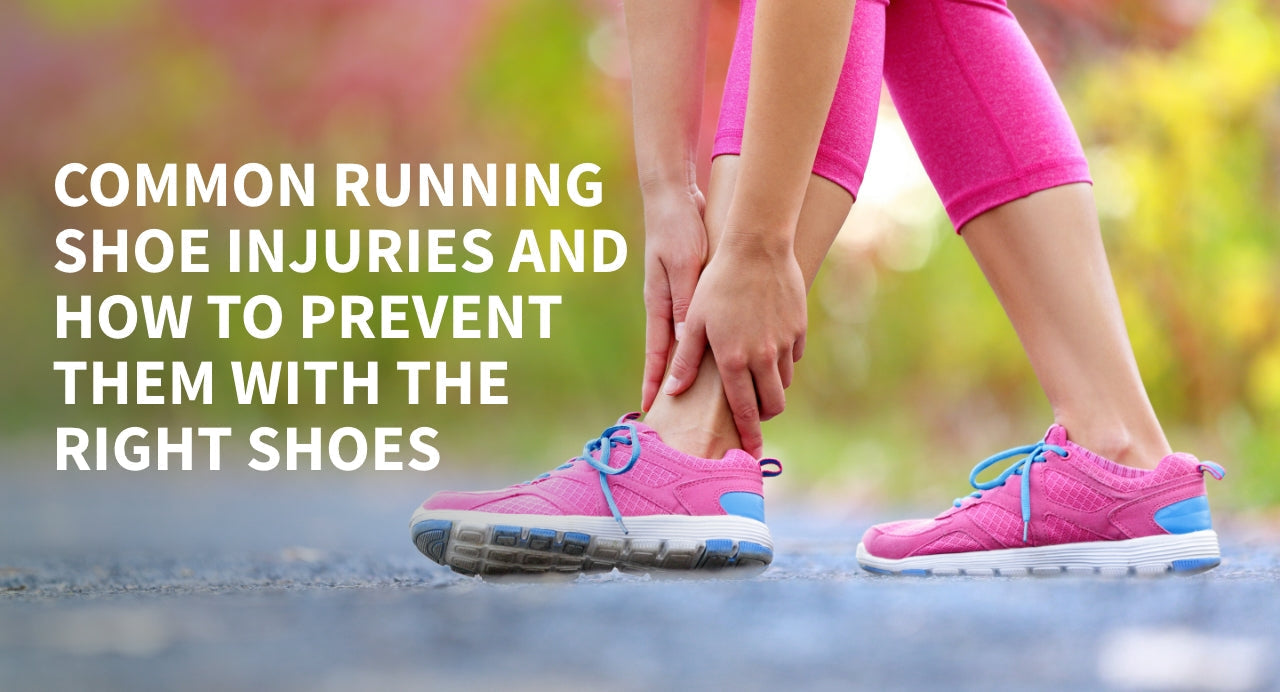11 Common Injuries Caused By Old Running Shoes (And How To Prevent Them)
Running is a great way to stay in shape, but using old and worn-out shoes can lead to a variety of injuries. In this article, we'll explore 11 common injuries caused by old running shoes and provide tips on how to prevent them. From blisters and shin splints to stress fractures and plantar fasciitis, we'll cover the most common injuries and the warning signs to look out for. We'll also discuss how to choose the right pair of shoes for your running needs and when it's time to retire your old shoes. Whether you're a seasoned runner or just starting out, this guide will help you stay injury-free and enjoy your runs to the fullest.
Schedule yourfree foot analysis
11 Common Injuries Caused By Old Running Shoes Explained
Running is a popular form of exercise, but wearing old shoes can lead to various injuries. From shin splints to back pain, the following are 11 common injuries caused by old running shoes.
Stress Fractures
An ankle stress fracture or a foot stress fracture is possible. The tension that the foot is under causes it to have minor initial symptoms that progressively worsen. Your risk of injury may rise if you wear unsupportive, uncomfortable, or stiff shoes.
Shin Splints
Shin splints, often referred to as medial tibial stress syndrome, are a common disorder that causes pain and discomfort along the shin bone (tibia) in the front of the lower leg. The muscles, tendons, and bone tissue in the lower leg are typically subjected to recurrent stress, which can lead to minor tears and inflammation. This is also a common injury for runners with flat feet.
Plantar Fasciitis
Foot-bottom irritation is one of the symptoms. It frequently affects people who wear tight-fitting shoes. If you get sudden aches in the base of your heel, you might have this issue. Avoiding shoes with inadequate cushioning is the greatest method to make sure that this pain goes away quickly.
Ankle Sprains
An ankle sprain is a common injury that occurs when the ligaments in the ankle are stretched or torn due to a sudden twist or turn of the foot. Ligaments are strong, flexible bands of tissue that connect bones to each other and provide stability to the joint.
Runner's Knee
Runner's knee, also known as patellofemoral pain syndrome, is a common condition that causes pain around the kneecap (patella). It is usually caused by repetitive stress on the knee joint, which can result in irritation and inflammation of the soft tissues and cartilage around the patella.
Patella Tendonitis
Patella tendonitis usually develops gradually and may initially cause mild discomfort or stiffness in the knee, which can worsen over time. In addition to pain and inflammation, other symptoms of patella tendonitis may include weakness in the knee, stiffness, and a crunching or crackling sensation when moving the knee.
IT Band Syndrome
When the band of ligamentous tissue (the iliotibial band) connecting the thigh bone and the pelvis tightens to the point that it rubs on the thigh bone, a painful condition known as iliotibial band syndrome develops. Long-distance runners are particularly at risk of IT Band Syndrome.
Extensor Tendonitis
Extensor tendonitis is a condition that causes pain and inflammation in the tendons that attach to the muscles that extend the wrist and fingers. It is usually caused by repetitive use or overuse of these muscles, which can result in small tears in the tendons and surrounding tissue.
Bunions
Bone malformations called bunions cause the big toe to turn in toward the second toe. Inflammation and dull, aching pain are common side effects. They're commonly linked to constricting footwear.
Hamstring Tendonitis
The foot, inner ankle, and outside edge tendons are all susceptible to inflammation. When this happens, it's usually a warning that your shoes need extra structure to prevent further inward rolling of the foot.
By donning appropriate footwear, you can forestall a plethora of foot problems.
Groin Strains
A groin strain is a type of injury that occurs when the muscles or tendons in the groin area are stretched or torn due to sudden movements or overuse. The groin area is located in the inner thigh and is composed of several muscles that work together to move the hip joint.
Protect your feet and body from injury by always wearing supportive and cushioned running shoes. Severe and expensive injuries are possible. The good news is that they are easy to avoid by just selecting the appropriate footwear.
Achilles Tendinitis
The achilles tendon is the tissue that connects your heels to your lower leg muscles. When there is repetitive stress on this tendon—caused by either tight calf muscles, naturally flat feet, sudden increase in mileage, ill-fitting or inappropriate footwear—, it can cause a condition called Achilles tendinitis. This usually presents itself as severe heel pain, especially in the morning on your first steps or with activity, as well as burning or pain and stiffness in the leg.
A good way to prevent this is properly stretching your calf muscles before a run or workout and wearing the right running shoes; to better help you prevent running injuries in general as well as for better running performance.
How to Prevent Running Injuries
Overuse injuries are rather frequent among runners, although they are not inevitable. The good news is that the measures taken to avoid one type of running injury are also effective against the other types. The following are some injury prevention practices that can help keep you and any runners safe from harm.
Don’t Increase Speed and Distance at the Same Time
Make modest progress and concentrate on lengthening your runs or picking up the pace, but don't do both at once.
Decide which to concentrate on. Running faster and farther at the same time increases your chance of injury because you might advance too quickly.
Learn to Differentiate Between Soreness and Injury Pains
If you want to push yourself physically by running, you should expect muscle soreness and discomfort but never ignore pain. Runners who increase their mileage or speed can expect to feel the effects of their workouts for several days afterward. However, pain or strong discomfort shouldn’t be acceptable, much less persistent pain that lingers after your soreness is gone.
Make Time for Cross Training
Although running may be your first focus, it's crucial to understand that sticking to a single, repetitive form of exercise makes it simple to develop an overuse injury.
The muscles that sustain your body when you run are strengthened by cross-training with weights and core exercises. You can run longer and more effectively as a result, and you also run less riskily.
Stretch Properly Every Time
Stretching keeps your muscles supple and lengthy, lessening the direct impact they absorb while you're running. A tight muscle is also more difficult to move correctly and effectively, which can result in bad running form.
Get Quality Running Shoes
Nowadays, there is a shoe for every activity, which may make you wonder if you actually need running shoes.
However, you should be aware that wearing the wrong shoes while running can alter your natural foot movement and raise your chance of developing an overuse injury from running.
If you run frequently or over long distances, it's worthwhile to invest in a pair of running shoes because they support the biomechanics and natural movement of your foot.
Consider the following when getting running shoes:
Pronation
When you run or walk, your foot naturally rolls inward or side-to-side. This is known as pronation. Normal pronation causes your foot to roll inward somewhat with each step because your foot's flexible medial-lateral arch flattens a little to lessen the force of landing on it. You consequently fall slightly more on the medial (or inner, or side of the foot that is closest to the opposite foot) edge of the foot.
While moderate pronation—again, up to 15 degrees—is typical and aids in shock absorption when you land, excessive inward rolling of your foot past this point is known as overpronation and can increase your risk of injury.
As a result, overpronating runners are more likely to suffer from ailments including IT band syndrome, shin splints, and plantar fasciitis.
Running shoes with motion control and stability features are made with pronation control and overpronation prevention in mind.
Cushioning
Most running shoes, whether minimalist or "barefoot" shoes, feature cushioning to help reduce impact loads and absorb shock when you run.
When you run, your feet experience forces that are roughly two to three times your body weight. All of the force that is not reduced by your running shoes and feet is transmitted up your lower limb to your bones and joints. To help absorb impact forces, running shoes use a variety of foams, gels, air, or other types of cushioning.
However, the cushioning materials degrade as you wear your running shoes like the supportive structures and materials that help prevent overpronation do.
Does Wearing Old Running Shoes Increase the Risk of Injuries?
Wearing the "wrong" running shoes for your body or running in old running shoes does not necessarily cause an injury; however, worn-out shoes or running shoes that aren't appropriate for your feet can certainly contribute to developing an injury, as can other factors like your overall training and your biomechanics.
The Real Reason You Get Injured
While shoes themselves are not the culprit behind a runner's injury, they can affect the maximum cumulative training load the body can withstand.
In other words, you shouldn't view your footwear as a panacea or the root cause of your ailments but rather as a preventative measure. Most running injuries are the consequence of cumulative microtrauma that builds up over time. The first step in improving your running is determining what shoes work best for you. This will allow you to absorb impact forces in the most efficient way for your body. When switching between shoes, the distribution of impact forces should change.
However, footwear works best if combined with adequate cross-training. Running on different surfaces, at different speeds, across diverse terrain, and with increasing distance and effort every day are all great ways to keep things interesting.
These fundamental rules can help you run more comfortably by reducing the impact forces your body experiences. Improving your body's resistance to that strain is the second most effective strategy for reducing injury risk. This can be achieved through regular strength training, healthy eating, regular physical activity, and sufficient rest.
Importance of Choosing the Right Pair of Shoes for Running
Shoes that are easy on the feet are the greatest kind. When your feet start hurting, you know you have the incorrect shoes on.
Here's why it's crucial that you pick the correct footwear for the occasion.
1. Avoid Pain and Blisters
Note that blisters can form on your feet if you wear inappropriate footwear and socks, which can lead to painful feet. Invest in high-quality running shoes to keep your feet healthy and free from blisters and pain.
2. Maintains The Shape of Your Feet
Wearing shoes that prevent your toes from moving around could alter the contour of your foot over time.
3. Knock-on Effect on Your Gait
The health of your feet and your gait efficiency will benefit from a good pair of shoes. The way you move could be affected by the shoes you wear. When you wear the wrong shoes, your body will acclimate to them, and your stride may alter, but you probably won't even realize it at first. Altering your walk to fit a new pair of shoes might lead to back and hip issues. This occurs because the foot is attempting to get some relief from the pressure exerted by the shoe.
How to Look for the Perfect Shoes for Running
The following are tips to keep in mind:
- The best time to try on a pair of running shoes is in the late afternoon, early evening, or immediately following a run. This is when your feet are thought to be at their actual size during the day. Trying on shoes while wearing athletic socks is another foolproof method.
- The space between the big toe and the end of the shoe should be at least an inch to ensure that your toes have room to wiggle.
- Third, you need a pair of running shoes that can withstand high mileage and last long. Think about things like how long the materials will last.
- You may locate running shoes that fit you perfectly and satisfy your specific needs by taking advantage of a force plate examination.
- Fifth, you should never run a race in brand-new sneakers. Before entering a race, you should have casually run at least 100 miles in the shoes.
What to Look for in the Perfect Pair of Shoes
Look for the following when wanting to get the perfect pair of running shoes:
- Over-pronation can be prevented if the shoes offer enough cushioning and arch support.
- Running shoes should be lightweight so that you can keep going for longer.
- Shoes should be flexible enough to allow the foot to bend and splay in any direction. As a rule of thumb, a more rigid foot requires a more flexible shoe to promote natural motion. A person with a flexible foot may benefit from wearing more rigid shoes.
- The fourth quality of a great sports shoe is increased cushioning and maximum responsiveness.
Call us for any doubt about common running shoe injuries and how to prevent them, and let us find you the perfect pair of running shoes in our catalog. Lucky Feet Shoes has the comfortable solution you've been looking for!
Request Your Personal Fitting
Jerick Sobie
Since 2005, I have been a dedicated small business owner specializing in footwear retail. With over 20 years of experience, my business partner and I have helped customers find the perfect shoes that combine style, comfort, and quality. Our expertise extends beyond local sourcing—we have traveled internationally to discover high-quality footwear that meets our customers’ needs. In addition to running my business, I have participated in numerous health fairs and educational seminars, sharing my knowledge on proper footwear and foot health. Committed to providing exceptional service, We carefully curate our selections to ensure the best fit and support for every customer.






















